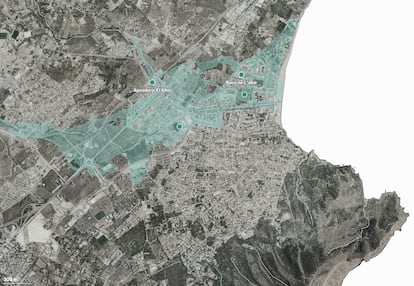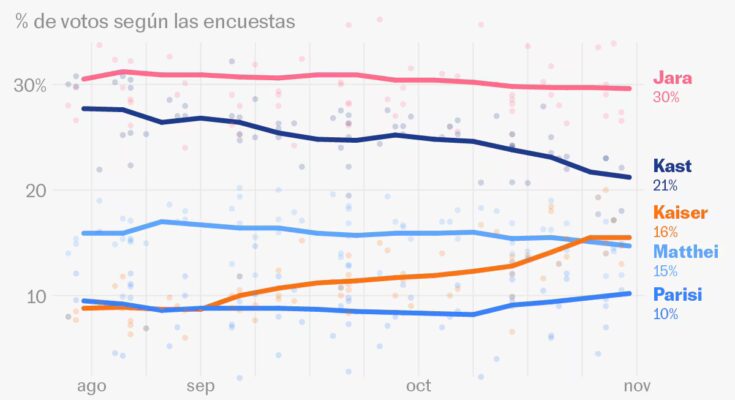This is a shipment of the Kiko Llaneras newsletter, an exclusive newsletter for EL PAÍS subscribers, with updated data and explanations: sign up to receive it.
This Sunday Chile will elect a president in an uncertain first round. Nobody expects the matter to be resolved here: the normal thing is for no candidate to reach 50% of the votes and on December 14th a run-off will take place between the two most voted. Furthermore, for the first time since 2012, the elections take place with compulsory voting, which adds to the doubts.
The latest public polls date back to ten days ago, when the electoral ban began. At the time, Jeannette Jara was clearly in the lead: around 30% of voting intentions, according to our poll average. Behind them were the right-wing candidates: the ultra José Antonio Kast (20%), the far-right libertarian Johannes Kaiser (16%) and the traditional right-wing candidate Evelyn Matthei (15%).
But the hypothetical second round polls complicate the picture for Jara. Although she led in the first vote, almost all polls show her defeat in the second round against right-wing candidates. In the Jara-Kast or Jara-Matthei scenarios, both scored between 10 and 15 points. Only in the Jara-Kaiser duel did her options improve, but without becoming a favorite.
But these are data from two weeks ago. Since then, polls can no longer be published in Chile, although they continue to be carried out for private campaigns and published outside the country. What we have is another source: prediction markets like Polymarket, where thousands of users bet real money on different outcomes. These markets aggregate dispersed information and often reflect the “wisdom of the crowd” about the likelihood of each scenario.
At Polymarket, forecasts continued to move during the ban. On Friday afternoon (Spanish time), bettors see the race like this: Kast would be the clear favorite (he would win 70% of the time), followed by Jara (15%), Kaiser (12%) and Matthei (2%).

These predictions are consistent with the polls, although perhaps they increase Kast’s favoritism over his competitors. In fact, on the same day of the polls, Kaiser recorded a rebound at the Polymarket and moved closer to Kast. But in recent days the money has returned to Kast.
The difference can be explained by another market: that of possible second round pairs. Polymarket contemplates three scenarios: Jara-Kast (70-80% probable), Jara-Kaiser (20%) and Jara-Matthei (3%).
In the first scenario, the victory of the far-right Kast is very likely (I estimate around 90%). The second scenario, if it occurred, would leave options for both Jara (40%) and Kaiser (60%), with the Libertarian slightly favored.
In summary: the forecasts describe elections with a clear but not decided favorite. Kast has the clearest path, with a 70% probability according to Polymarket. But this means that almost one in three times – much more than a statistical rarity – the presidency will go to another candidate. Tomorrow Chile will vote with a favorite, but without a certain winner.
More news
🌊 1. Map of flood zones
We have published a map of the whole of Spain with thousands of infrastructures at risk of flooding, in the event of an extreme flood like the one that devastated the towns in the south of Valencia. They are schools, hospitals, sports facilities or nursing homes.
In the article you can consult municipality by municipality.

There are some locations where practically the entire municipality is located in a potentially flood zone, such as Santa Cristina de la Polvorosa (Zamora) or Sant Jaume d’Enveja (Tarragona).
The maps are also technically spectacular. We use aerial imagery from IGN with an extreme level of detail. It is a work by Montse Hidalgo, José A. Álvarez and Daniele Grasso: Schools, football fields or residences: in which municipalities are places at risk of extreme flooding.
💼 2. One million Latin affiliates
This year, Latin Americans surpassed the iconic figure of one million Social Security enrollees, making them the second largest group of foreign workers, after Europeans.
Emilio Sánchez and Montse Hidalgo analyzed which sectors they work in and which communities they live in: Spain already exceeds one million Latin American affiliates: where are they and what do they do?
📘 3. Three books on AI
I have been reading about artificial intelligence and three books particularly interested me.
Deep learning with Pythonby François Chollet. A practical and technical text, ideal for understanding how modern models are built. Andrej Karpathy’s YouTube videos are also excellent for the same purpose.
Artificial intelligence. Guide for thinking beings (Captain Swing), by Melanie Mitchell. Available in Spanish, it is a clear and entertaining book that traces the essential elements of the leap forward in artificial intelligence after 2012.
What is intelligence?by Blaise Agüera y Arcas. It was just released and I was thrilled with it. It is an ambitious essay on intelligence, evolution and machines. It talks about both biology and artificial intelligence and that’s probably why I liked it so much.
This is a shipment of the Kiko Llaneras newsletter, an exclusive newsletter for El País subscribers, with updated data and explanations: sign up to receive it.



